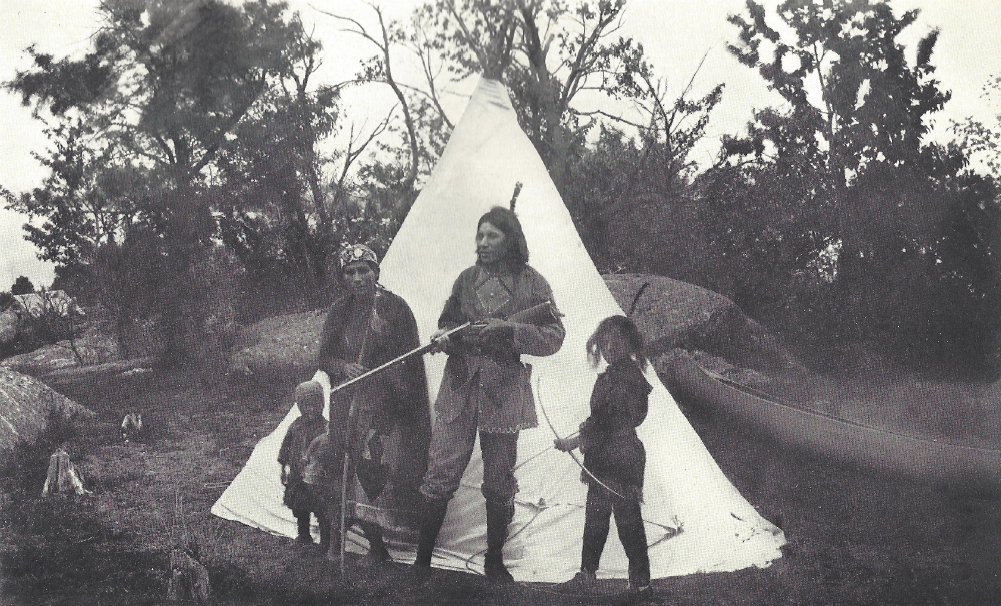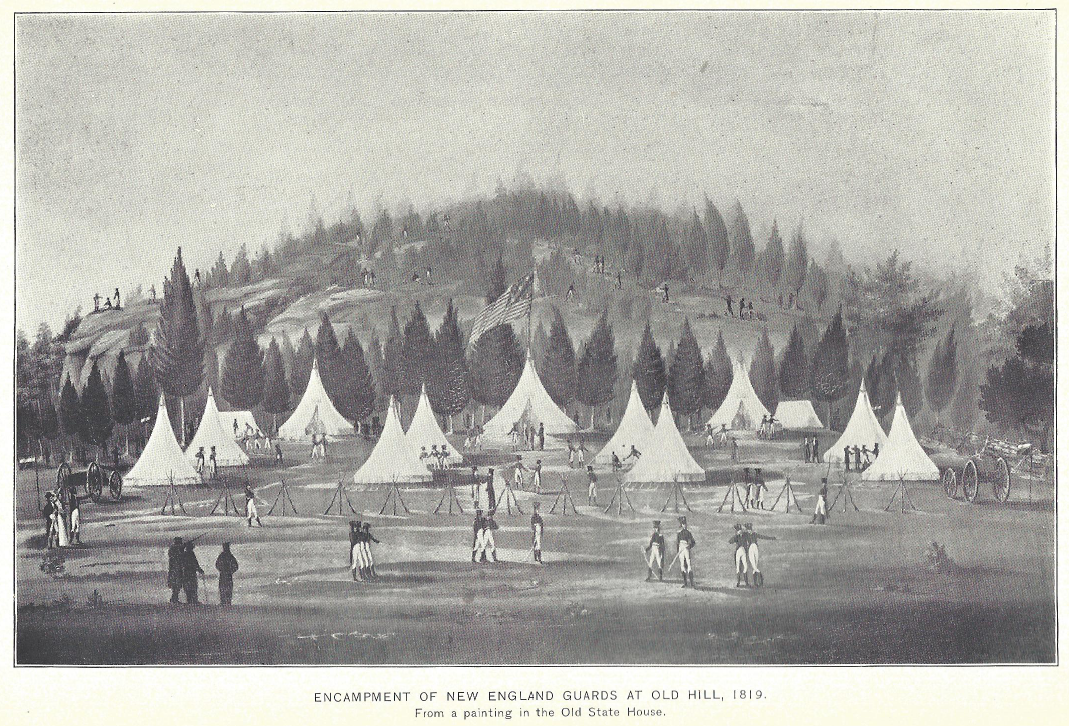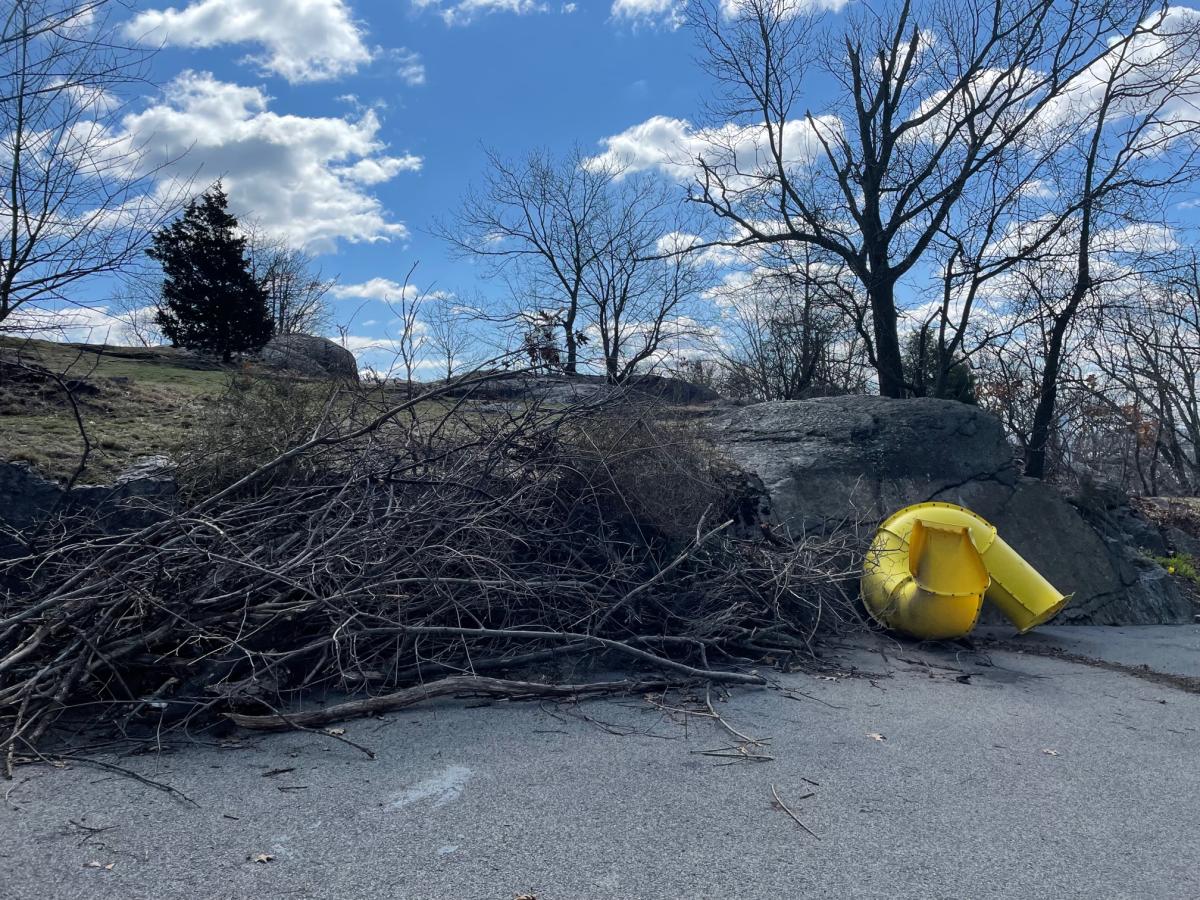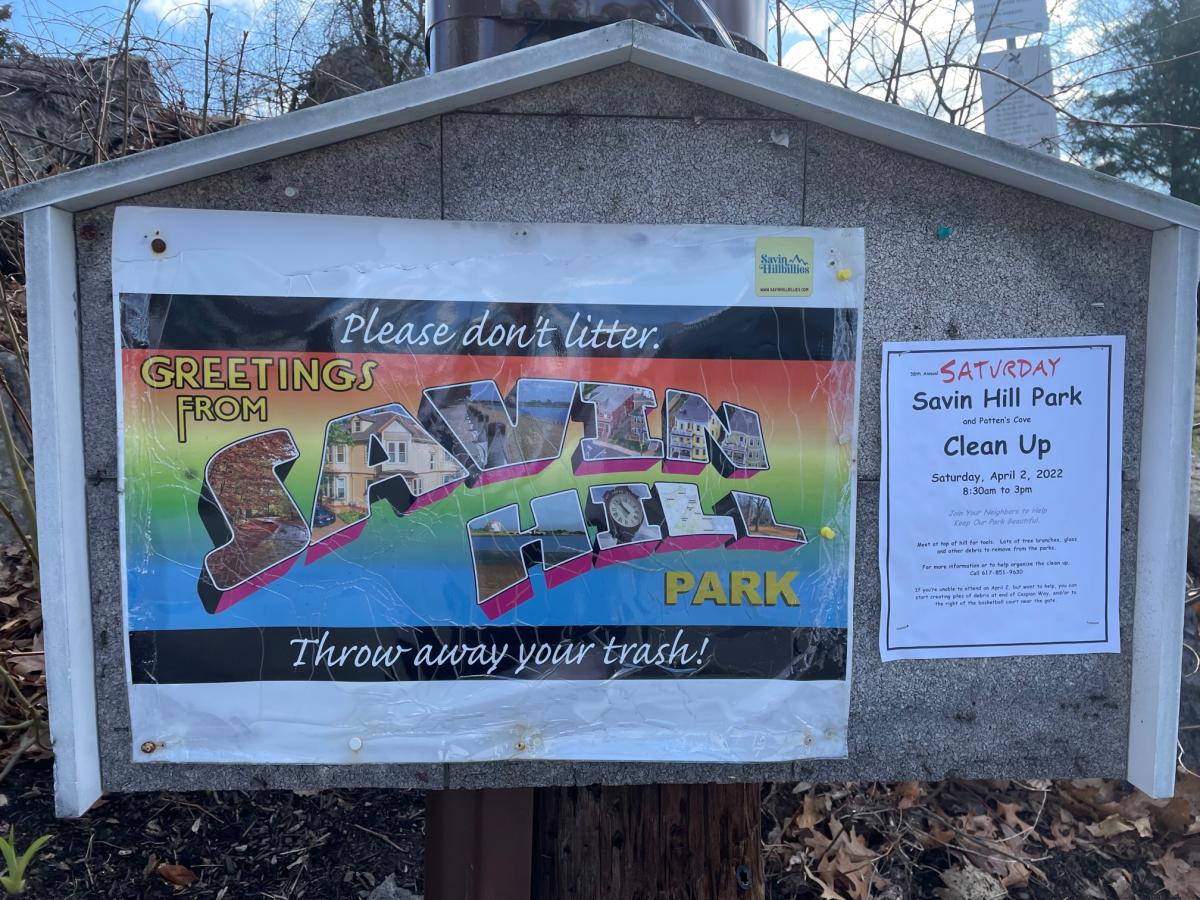April 6, 2022

City Councillor Frank Baker and Kirk Carapezza removed a discarded tube from Savin Hill Park at the 38th annual cleanup on Sat., April 2. Bill Walczak photo
The Friends of Savin Hill Park held its 38th annual Savin Hill Park cleanup up this past Saturday. The cleanups have been essential to the restoration of the top five acres of the park, with each year achieving an incremental improvement. This year, a group from the Patten’s Cove area asked to be part of the cleanup.
Boston’s parks are well known in the world of urban parks, thanks in part to the work of world-renowned park designer Frederick Law Olmsted’s in the late 19th century creating the Emerald Necklace. The Necklace starts at the Boston Common and winds its way down the Muddy River to Jamaica Pond, then via the Jamaicaway to the Arboretum and Olmsted’s main gem – Franklin Park.
Olmsted’s plan was to continue the chain of the necklace along Columbia Road to the Boston waterfront, but, sadly, that was never completed. The existing Olmsted parks have much support and special funding sources and are generally in excellent shape.

A photo from 1884 by James Stark shows what was termed the "last Indian camp on Savin Hill... on the site of the old fort." The photo was featured in a book "Good Old Dorchester," by William Dana Orcutt in 1893.
Boston has many other parks that are wonderful places for residents to experience nature and fresh air, such as the state-managed Neponset River Reservation and Pope John Paul II Park, and Boston Parks Department-managed parks such as Dorchester Park, Almont Park, Malcolm X Park, and the park that I see every day, Savin Hill Park. Neighborhood parks get much less maintenance and support than the Olmsted parks.
Savin Hill Park was part of lands of the indigenous Massachusett tribe prior to the Puritan settlement. In the book “Dorchester Day Celebration, 277th Anniversary, 1907,” there is a photo from 1884 entitled “The Last Indian Camp on Savin Hill,” indicating that the tribe continued to use Savin Hill late into the 19th century. Upon their arrival in 1630, the Puritans named the hill Rock Hill, due to its rocky outcroppings of Puddingstone. Being about 100 feet above sea level, and right on the waterfront, it was used by the Puritans in 1639 for “great guns,” that is, cannons, to protect the new settlements from the French, who, the Puritans feared, would contest their settlements along Boston’s waterfront.
Savin Hill sat at the southern end of George Washington’s troop array in the early years of the Revolutionary War. It was fortified again during the War of 1812, and was an encampment of soldiers for many years. It was the subject of an 1819 painting that is in the possession of the Old State House Museum.
We know that the hill’s name changed to Olde Hill from 1730 to 1830, at which point Joseph Tuttle, who owned the Tuttle House Hotel, where Cristo Rey School is now, renamed the site Savin Hill, after the trees that abounded there.
A commission created around 1900 to look at ideas for new parks for Boston recommended that Savin Hill, then owned by the Worthington Family, whose home was the old St. William’s Rectory on Dorchester Avenue (now demolished), be made into a park. The First Dorchester Day was held at the summit of Savin Hill in 1904, during which leaders joined the call for making Savin Hill into a park.

From the book "Good Old Dorchester," an illustration (above) shows the "Encampment of New England Guards at the Old Hill, 1819."
One of the people at that ceremony was John “Honey Fitz” Fitzgerald, who promised that if he were elected mayor, he’d make Savin Hill a city park. After he was elected, Savin Hill became a park on July 26, 1907.
In the process of making the park, the “Savin” trees were eliminated in favor of planting the oak trees that ring the park.
For the 100th anniversary of the park in 2007, the Friends of Savin Hill Park, after viewing the 1819 painting, decided to plant some “Savin” trees, and approached the Parks Department to get some. We wrote a grant to the Parks Department that resulted in some money to buy some “Savin” trees, but when the Parks arborist, a man beguilingly named Leif Fixen, tried to buy some, he found that the tallest “trees” he could get were 18 inches tall. This made no sense at all, considering the painting in the Old State House.
At that point, a then-Savin Hill resident, Matthew Gordy, a landscape architect, looked into the issue, and found that Joseph Tuttle was actually referring to what we now call Eastern Red Cedar trees, and that the common name for those trees in the 19th century was “Savin tree.” We eventually got three Eastern Red Cedars, and planted two near the tennis court and one along Caspian Way.
The annual Savin Hill Park cleanup started when I purchased my house in 1981. Savin Hill has an amazing view; out to Hull on the east, the Blue Hills on the south, downtown to the north, and into Roxbury on the west. But when I bought my house, the sunrise exposed thousands of shards of glass left by groups of youth who had broken thousands of beer bottles there over the years. One group included the now-famous Mark Wahlberg, whom I confronted regularly, to no avail.

The Parks Department ignored the top five acres of the park, on the basis that it was not used for organized sports and, therefore, an urban wild, for which there was no maintenance, though occasionally the department would have to remove stolen cars that had been pushed over the cliff at the top of the hill. Things got so bad that houses near the park would put air conditioners in their windows mainly to create white noise to obliterate the sounds of partying youths and breaking bottles at night. One neighbor referred to the park as “Hiroshima Park,” and it was generally viewed that living next to it was a very negative thing.
But some neighbors saw the potential of the park, and when I started raking the glass up in my first couple of years next to it, they asked that I let them know when I was raking so they could join in. That led to the first invitational cleanup in 1985 and the Friends volunteer group. Every year since then, a general cleanup is announced by the Friends, and between 30 and 40 people will show up to rake leaves, remove dead trees and branches, and pick up glass. It took about fifteen years of cleanups to clear the top of the park of most of the glass, but there seems to be an unlimited supply of shards along the cliff walk on the southern side of the hill. This year, City Councilor Erin Murphy joined others in targeting glass removal there.
The Friends of Savin Hill Park cut the grass at the top of the hill, and provided daily trash removal and other maintenance for decades. Today, the park is in much better shape and has fewer problems with vandalism, though there is still much graffiti and glass to remove. Though “Friends of Parks” groups are a wonderful community building experience, it’s shameful that our city has neglected neighborhood spaces such as Savin Hill Park for so many years that it is only through the efforts of neighborhood volunteers that maintenance happens.

The Parks Department missed a big opportunity when the Parks Commission didn’t include improvements to the park and removal of dead trees when they approved the new condo developments at 55 Alpine Way and 147 Grampian Way, which abut Savin Hill park. Park friends groups should be planting flowers, not cutting grass, removing dead trees, and extracting glass from walkways. Our state and city governments need to staff their park systems sufficiently to ensure that they are reasonably maintained.
And so, until that happens, we salute those who came out last week to provide maintenance for Savin Hill Park and Patten’s Cove: Sue Wadlington, Dave Butler, Alix Gianetti, Aaron Berger, Thomas Mannion, City Councilor Erin Murphy, Dave Mareira, Kirk Carapezza, Elizabeth Walczak, Chris Gianetti, Sarah Miller, Matt Collamer, Meg Campbell, Emily Lichtenstein, the Moore Family, Sue Schardt, Randy Tobin, Wyatt Griffith, Chuck Monroe, Katrina Martin, Angus Smith, Rob Kimball, Erin Kimball, Bert Bremer, Karen Fegley, Walter Fernandes, Thalia Yunen, Jin Tao, Steve Weymouth, Marc Antoine, Bobby Spano, City Councilor Frank Baker, Antoni Smith, Steve Smith, and Deborah Lenares (and others who didn’t sign in).


